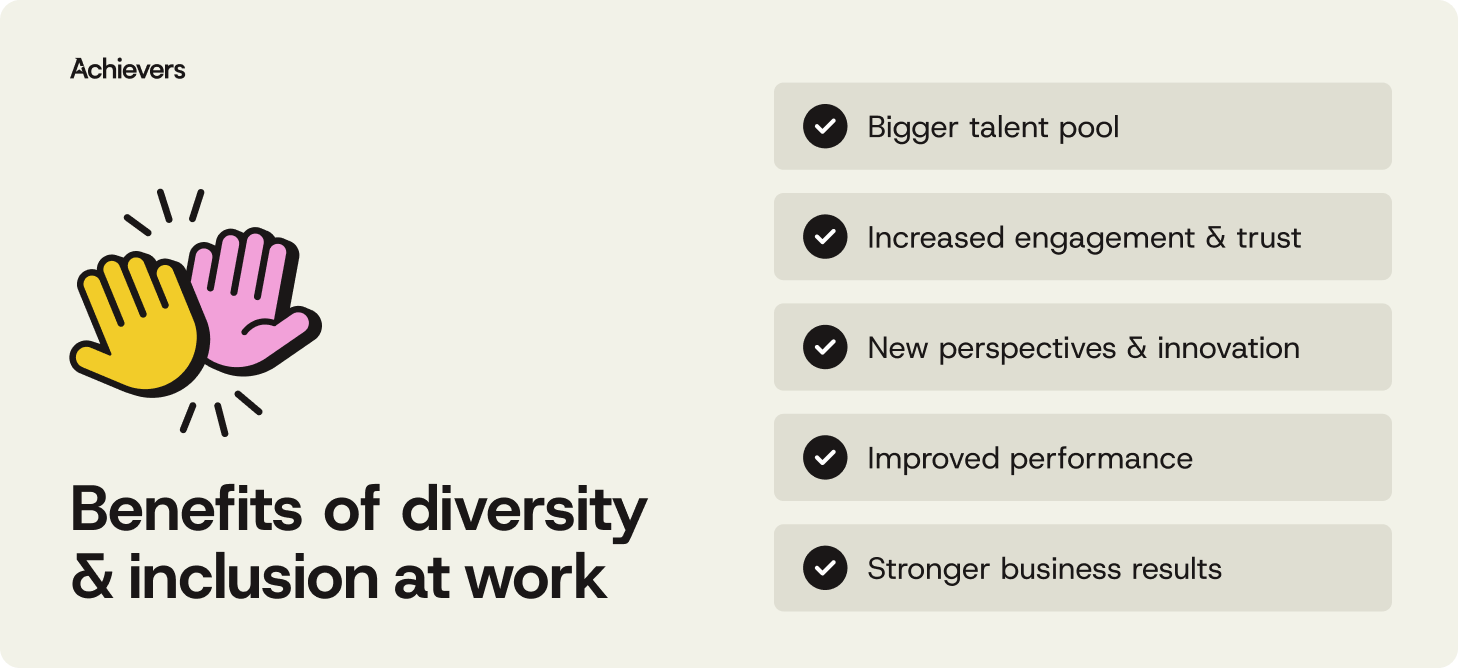Table of contents
Create a culture that means business™
Schedule a demo with an Achievers solution expert today.
Here’s the thing — diversity and inclusion aren’t just HR buzzwords anymore. They’re things people care about when choosing where to work. In fact, more than 3 in 4 job seekers say they consider workplace diversity before accepting a job offer. If your culture doesn’t reflect that, you could be turning away talent before they even apply.
The good news is that you don’t need a brand-new playbook to build a more inclusive culture. It starts with the people you already have — and the everyday behaviors that make your workplace more connected, supportive, and real.
In this blog, we’re digging into the traits that help employees show up fully and help each other do the same. Because inclusive workplaces aren’t built in a day. It takes ongoing authentic work to create a space where all employees can thrive.
What is diversity and inclusion in the workplace?
Diversity and inclusion (D&I) in the workplace refers to creating an environment in which everyone feels valued, respected, and able to bring their authentic selves to work, regardless of their identity. Specifically, diversity is the mix of people from different backgrounds, each with their own unique experiences, values, and perspectives. Inclusion is the practice of creating a welcoming environment where employees feel empowered to contribute, are respected, and heard.
Benefits of diversity and inclusion at work
Diversity and inclusion aren’t just about checking boxes or hosting one-off lunch-and-learns. When done right, they create something deeper — a sense of belonging that makes people want to stay, contribute, and enjoy showing up to work. Bonus: they also happen to be really good for business. Here’s why:

1. Bigger talent pool
Casting a wider net in your hiring process — across backgrounds, ethnicities, generations, and experiences — doesn’t just look good on paper. It helps you find the right person for the job, not just the most obvious one.
Need proof? Delta Airlines credits a 10% boost in global market penetration in 2024 to its stronger focus on diversity and inclusion. Turns out, when your team better reflects the world outside your office walls, opportunities tend to follow.
2. Increased engagement and trust
When people feel included, they’re more likely to speak up, stay engaged, and go that extra inch (or mile) for their team. Inclusive workplaces also see fewer sick days and better overall well-being — probably because no one’s burning out trying to fit into a mold that doesn’t fit.
3. New perspectives and innovation
Bringing together different voices isn’t just good for culture — it’s good for problem-solving. Diverse teams are less prone to group thinking and more likely to find fresh, creative solutions. More angles = better ideas. Simple math.
4. Improved performance
Diversity is also a major performance driver. Companies with greater racial and ethnic diversity are 35% more likely to outperform their competitors. Because when your team sees things from more sides, they have everything they need to deliver results that actually land.
5. Stronger business results
At the end of the day, inclusion isn’t just the right thing to do — it’s the smart thing to do. It sharpens strategy, fuels innovation, and drives results. In fact, 71% of leaders with mature DEI strategies say they usually beat competitors to market. That’s not just good culture — that’s competitive advantage.
Challenges of workplace diversity and inclusion
Creating a diverse and inclusive workplace sounds great — until you actually try to do it. From big-picture strategy to everyday behavior, there’s a lot that can get in the way. Here are some common roadblocks:
- Leadership involvement: DEI can’t just live in HR. If leaders aren’t visibly backing it — with budget, accountability, and real commitment — progress fizzles fast. It takes senior voices asking hard questions and showing up, not just signing off.
- Measurement: A yearly survey isn’t enough. Our 2024 Engagement and Retention Report found only 25% of employees say their employer has asked for feedback on DEI. If you want the full picture, you need to listen continuously, dig into the data, and — most importantly — act on what you hear.
- Intervention and training: One workshop won’t shift the culture. People need real guidance on what inclusive behavior looks like — from how they hire to how they run meetings. Managers especially need tools, not just talking points, to lead inclusively.
- Silos: When teams stay in their own corners, inclusion suffers. Silos make it harder to share ideas, build trust, or see beyond your bubble. Breaking them down starts with connection — think recognition, shared wins, and cross-team collaboration.
Strategies for fostering diversity and inclusion in the workplace
Building an inclusive workplace doesn’t happen by accident — it takes daily, deliberate effort. Here are key strategies that help turn good intentions into lasting impact:
- Set clear, objective criteria: Bias shows up when expectations aren’t clear. Use consistent, skills-based criteria to guide decisions — whether you’re hiring, promoting, or assigning work. Make sure your team’s aligned on what matters, write it down, and check in regularly to keep things fair for everyone.
- Recognize and reward inclusively: Recognition fuels belonging. Call out not just wins, but the values and behaviors that make your culture stronger. When appreciation flows from leaders, peers, and everywhere in between, people feel seen — and more likely to stick around.
- Measure what matters: D&I success isn’t a vibe — it’s measurable. Use tools like engagement surveys and voice-of-the-employee platforms to uncover blind spots, track sentiment, and gather feedback in real time. Then act on it. Otherwise, why ask?
- Empower employee resource groups (ERGs): ERGs and inclusion councils help employees connect, share perspectives, and shape culture from the ground up. When supported properly, they’re not just affinity groups — they’re engines of innovation and belonging.
- Make psychological safety non-negotiable: People should feel safe speaking up — whether it’s flagging a concern or sharing a new idea. Normalize feedback, embrace vulnerability, and build trust at every level. Without psychological safety, inclusion stays surface-level.
- Gather (and act on) feedback: If you’re not regularly checking in with employees about your D&I efforts, you’re guessing — and guessing isn’t a strategy. Use targeted surveys to learn what’s working, what’s not, and where to go next. And yes, action is part of the ask.
- Bake inclusion into hiring — and everything after: Hiring is just the start. Train hiring managers on bias, diversify interview panels, and build equitable practices into onboarding, performance reviews, and team dynamics. Real inclusion means making sure those voices aren’t just present, but actively supported and encouraged to lead, share, and shape the culture.
- Document and share best practices: Clear policies set the tone. Keep your code of conduct up to date, accessible, and reflective of your company’s values. Regularly reinforce non-discrimination policies through training — and make sure they’re more than just fine print.
Getting started: Unlock the full potential of a diverse and inclusive workforce
Diversity and inclusion don’t thrive because of a mission statement — they thrive when they’re lived, reinforced, and recognized every day. From inclusive hiring to psychological safety to recognizing the people who model your values, the strongest cultures are built on consistent action.
That’s where Achievers comes in.
Our recognition platform helps organizations move from intent to impact — by recognizing inclusive behaviors in the moment, supporting ERGs with visibility and rewards, and listening deeply through real-time feedback tools. You’ll have the insights to know what’s working, the tools to reinforce what matters, and the power to scale belonging across your workforce.
Because inclusive workplaces aren’t just built from policies — they’re built from people. Representation opens the door — but inclusion is what makes people want to stay. And recognition is how you show them they matter. And we’re here to help you support them, every step of the way.
Diversity and inclusion FAQs
Key insights
- Top talent values diversity and inclusion in the workplace
- Diversity and inclusion at work drives stronger business results
- Creating a strong D&I starts with the employees you already have



